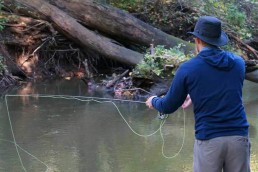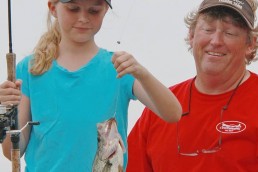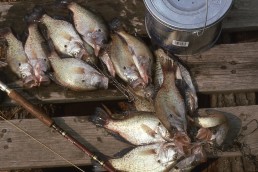Indiana Duneland Spring Crappies on the Fly
SHARE THIS POST
The key to locating and hooking up is to know exactly what stage the fish are in.
Biologists have identified two strains: the black crappie (Pomoxis nigromaculatus), which prefers clearer waters with an abundance of submerged aquatic growth, with a sandy or muck bottom, and the white crappie (Pomoxis annularis), which is more adaptable to stained water and a silt bottom. Both strains are sight-feeders, and their eyes are large and set high on their heads. These also hear well and are easily spooked therefore a stealthy approach is essential. The adult crappie’s food base consists of aquatic insects and minnows.
During the pre-spawn and post-spawn stage, this is prime-time fishing. Crappies will position themselves on the first major break out from a nesting area and are in an aggressive feeding mood. They also tend to gather and move in loose groups. While a group of crappies can be located on or near the bottom, their tendency will be to suspend over or next to submerged structure: weedlines, fallen timbers, stumps and brush piles.
Crappies will start their spawn when the water temperatures are between 60 to 65 degrees. The male crappies head into shallow water that has stemmed vegetation cover—providing protection from heavy wind and wave action—and start fanning an indented nest. Once the nest is prepared, the female crappies will arrive and deposit their eggs while the males remain to protect the eggs and the coming fry.
I’ve caught crappies on nymphs and wet flies, but the most productive fly pattern has been the streamer. These fish eagerly feed on minnows, and the streamer provides the appearance of a minnow, but the retrieve needs to mimic a minnow working its way through water.
Are you enjoying this post?
You can be among the first to get the latest info on where to go, what to use and how to use it!
My streamer choices are the Molly Mouse Streamer, Minnow and Bucktail Minnow. The Molly Mouse Minnow and Clouser Minnow are weighted with dumbbell eyes that aid in getting and keeping a fly in the strike zone. An unweighted Bucktail Minnow is a good choice for working shallow water 3 feet deep or less. The streamer length should be 1 1/2 to 2 1/2 inches (size 10-6). For presenting the streamer patterns to the fish, I start with a slow “strip, strip, strip,” 2- to 3-second pause and then repeat the retrieve. If I’m not drawing strikes and hooking up I will change my presentation (retrieve, speeding up or down). Still no hook-ups, then I will change the size of the fly and use a different color. Try variations and let fish tell you what they want.
A hooked crappie is not known for blazing speed and powerful runs, but turning their flat body to create resistance makes them difficult to move, and can make a hook to come free. My setup is straightforward and consists of a 3-wieght rod—4-weight if the wind is uncooperative—and matching weight-forward floating line on a disc-drag reel and 4X leader with a 5X fluorocarbon tippet at 9 to 10 feet in length.
Molly Mouse Streamer, Olive
Hook – Mustad 3366, sizes: 6 to 10
Thread – Red
Weight – Bead Chain Eyes
Tail – Natural Turkey Tail with Silver
Krystal Flash
Body – Olive SLF Dubbing
Nose – Red Tying Thread
The bead-chain eyes are mounted on top of the hook shank to invert the hook, making this a virtual snag-proof fly.
Additional color patterns: Chartreuse, Tan, White and Yellow.
Clouser Minnow, Olive/White
Hook – Mustad 3366, sizes: 6 to 10
Thread – White
Weight – Bead Chain Eyes
Body – White Tying Thread with White Bucktail
Wing – Olive Bucktail over Gold Krystal Flash
Nose – Olive Tying Thread
The bead-chain eyes are mounted on top of the hook shank to invert the hook, making this a virtual snag-proof fly.
Additional color patterns: Chartreuse/ White, Tan/White, Yellow/White.
Bucktail Minnow, Olive/White
Hook – Mustad R73, sizes: 6 to 10
Thread – Black
Body – Silver Flat Tinsel
Belly – White Bucktail
Wing – Peacock Herls over Olive Bucktail and Silver Krystal Flash
Head – Black Tying Thread
Additional color patterns: Chartreuse/White, Yellow/White.
MWO
SHARE THIS POST
Did you enjoy this post?
You can be among the first to get the latest info on where to go, what to use and how to use it!
Andy Satanek
MidWest Outdoors works with more than 200 outdoor experts each year, who contribute articles based on their areas of expertise. MidWest Outdoors magazine offers more fishing and hunting articles than any other publication!



